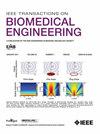Development and Evaluation of a Robotic System for Safe Cardiac Sheath Delivery
IF 4.5
2区 医学
Q2 ENGINEERING, BIOMEDICAL
引用次数: 0
Abstract
用于心脏鞘安全输送的机器人系统的开发与评估。
目的:本研究旨在开发和评估一种3自由度(DoF)机器人系统,用于通过具有挑战性的解剖结构(包括卵圆窝和具有紧密曲线的通路)安全递送心脏鞘。方法:在先前提出的单自由度驱动模块和弯曲模型的基础上建立机器人及其运动学模型。开发了一种鞘输送策略(SDS),结合了两种控制方法:尖端位置控制以接近最佳入口点,以及点约束控制以保持通过该点的一致导航,最大限度地减少组织接触。通过轨迹跟踪和点交叉测试来评估技术性能,然后在模拟场景中进行可行性实验。试验由三位心脏病专家在透视引导下使用经过验证的幻影模型进行,将SDS与关节控制(JC)和手动控制(MC)进行比较。结果:针尖位置控制的均方根误差为2.10 mm,点约束控制的均方根误差为1.86 mm。SDS以更短的轨迹长度和更低的均方根差显著优于MC。与JC相比,SDS减少了鞘诱导的运动(一种间接测量力的方法),增加了卵圆窝的牵入成功率。结论:与JC相比,该机器人系统减少了与组织壁的接触,提供了比MC更平稳、更可控的操作,确保了更安全、更有效地通过受限路径进行输送。意义:这项工作有助于推进机器人辅助心脏鞘输送,为具有挑战性的解剖结构导航提供可靠和更安全的方法。
本文章由计算机程序翻译,如有差异,请以英文原文为准。
求助全文
约1分钟内获得全文
求助全文
来源期刊

IEEE Transactions on Biomedical Engineering
工程技术-工程:生物医学
CiteScore
9.40
自引率
4.30%
发文量
880
审稿时长
2.5 months
期刊介绍:
IEEE Transactions on Biomedical Engineering contains basic and applied papers dealing with biomedical engineering. Papers range from engineering development in methods and techniques with biomedical applications to experimental and clinical investigations with engineering contributions.
 求助内容:
求助内容: 应助结果提醒方式:
应助结果提醒方式:


